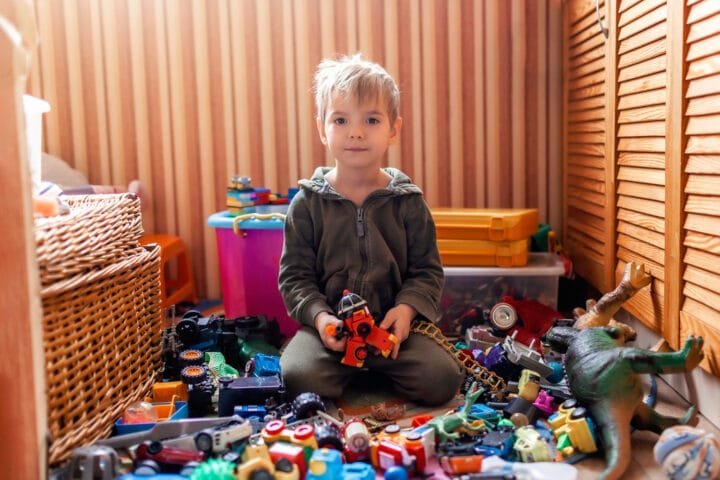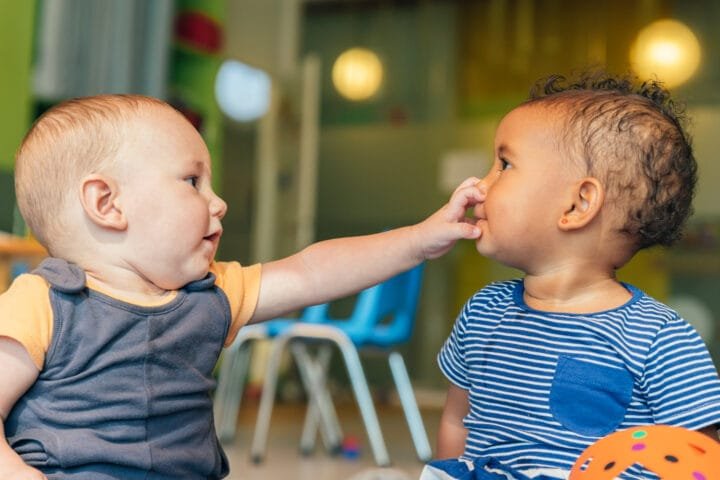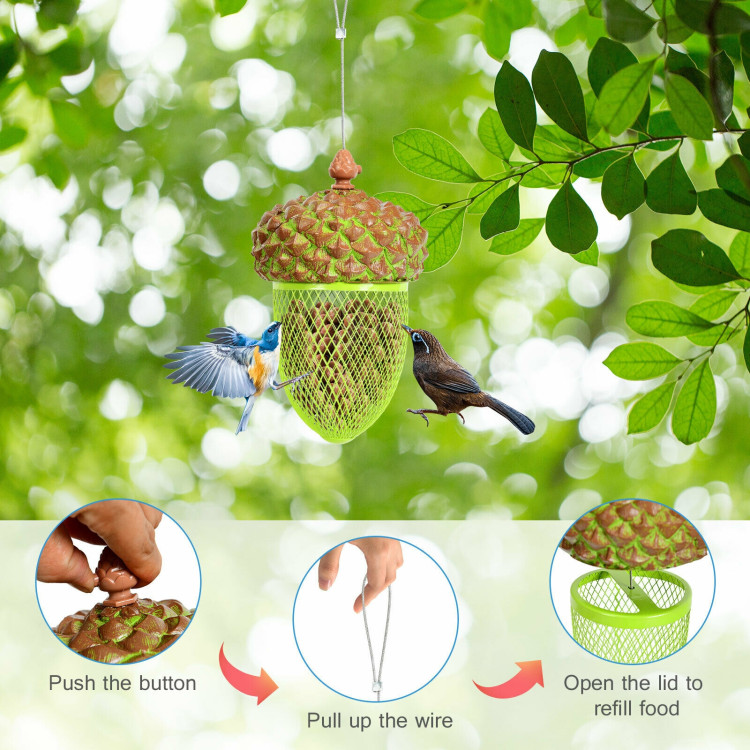How can pets help you raise your kids? (Hint: they can help a lot!)
Those heartwarming videos are of a golden retriever patiently enduring a toddler’s “loving” (read: slightly aggressive) hug. You love them. But did you know they do more than make cute photo ops? They shape those little humans into well-rounded individuals. It’s like a four-legged therapist, a trainer, and a best friend all rolled up into one. Here’s what you need to know about pets and child development.
A Furry Friends Guide to Emotional Development
Have you ever seen your child run to their furry companion when they skinned their knee? It’s not just a random act of comfort-seeking. Even the best-intentioned humans can’t always provide unconditional love and companionship like pets do. If you have a messy room or a temper tantrum, they don’t judge. They’re just there, a warm, furry presence offering silent support and a comforting purr (or lick, depending on them). This brings a sense of joy and comfort to your child, reassuring you as a parent that they are never alone in their journey of growth.
It’s not just anecdotal. According to a study published in the journal Social Development, children with pets show more empathy and prosocial behavior than kids without pets. According to the researchers, children with pets are more likely to play with others, offer help, and comfort others in distress.
Think about it: petting a dog or cat can lower your blood pressure and release oxytocin, the “love hormone,” which relaxes you. A furry friend can make a huge difference in today’s world, where kids face increasing pressures and stimulation from social media, academic expectations, and the fast-paced world. University of York researchers found that kids with pets felt less stressed about school and social situations in 2019.
But it’s not just about receiving love; it’s about giving it too, and caring for a pet, whether a goldfish, a hamster, or a Great Dane, cultivates empathy and compassion. As they grow, they learn to respect all life forms, recognize another’s needs, and understand responsibility.
As my son used to be afraid of our grumpy old cat, he now treats her like a gentle giant. After refilling her water bowl, he even started sharing snacks with her (much to my dismay!). For the first time, he gained empathy beyond our feline overlord. He would help his friends whenever they were upset, just like he comforted our cat when she was feeling unwell, and even rescued earthworms stranded on the sidewalk after a rainstorm, showing compassion for all living creatures.
It’s true; pet care and empathy go hand in hand. According to a study published in Anthrozoös, children who care for their pets show more empathy and are more likely to help animals and humans. It’s said that taking care of a pet helps kids develop emotional intelligence and perspective-taking.
Pets and Interpersonal Skills: Paws-itively Social
Did you ever notice how easy it is for kids with pets to make friends? It’s not just a coincidence. Pets are social catalysts, facilitating interaction and communication. If you see a dog in a park, other kids will be drawn to him, providing an icebreaker and a shared interest. It’s a classic conversation starter to ask, “What’s your dog’s name?” and then play fetch, share treats, and become friends. This role of pets in promoting social skills should make you feel optimistic about your child’s social development.
A study published in the Journal of Applied Developmental Psychology found that children with dogs interact socially in public settings more. Children were encouraged to initiate play when the dog was around and shared a common ground.
By walking the dog, cleaning the hamster cage, or feeding the fish, kids learn about routine, commitment, and caring for others. Pets spark initial connections, but they also help kids become socially responsible.
They learn to communicate effectively with others, as they have to interact with other pet owners at the park or when visiting the vet. It’s the seemingly mundane tasks that lay the groundwork. Kids who care for their pets are more responsible around the house, prioritize, manage their time, and understand how neglecting their responsibilities affects them for example.
Remember how good it feels to have a furry friend by your side in social situations. Pets provide security and loyal companionship to help you through awkward times.
When my daughter got our dog, Bailey, she gained the confidence to play with other kids. Bailey became her wingman, her furry ambassador. She used to cling to me at every social gathering, but now she’s blooming. Having gained this newfound confidence, she auditioned for the school play and participated in class discussions with him. She proudly told other kids about his quirky habits and amazing tricks.
A study published in the journal Child Development found that pet owners are more likely to feel socially isolated and less lonely than those who don’t own pets. When kids have pets, they feel like they belong.
The Brain Booster: Pets and Cognitive Growth
Pets aren’t academic tutors, but they contribute significantly to cognitive development. Kids learn how to respond to their pets’ cues from a young age.
In addition to expanding their vocabulary and improving non-verbal communication, this constant interaction helps them develop their language and communication abilities. When toddlers play with their pets, they might learn words like “dog,” “cat,” “hungry,” and “walk.” They start interpreting non-verbal cues as they age, like a dog’s body language or a cat’s purring, which makes them better understand it.
Additionally, pet care builds organizational skills and accountability, which enhances learning. How often do we make charts to remind our kids to brush their teeth and make their beds? Adding “walk the dog” or “feed the fish” is a great way to teach responsibility and time management. Children develop skills that translate into better academic performance by prioritizing tasks, managing their time, and following through.
In addition to structure and routine, pets also spark children’s curiosity. Seeing a cat chase a bird, a dog chase a ball, or a fish in its tank can spark questions, observations, and a thirst for knowledge.
It was a simple pet, but it opened up a world of learning and exploration. We spent countless afternoons huddled around our ant farm, fascinated by those tiny creatures’ tunnels and tireless efforts. It gave us a deep understanding of the natural world and a love for science. It was a great way to understand the ant species and their social structures.
According to a study published in Developmental Psychology, children with pets performed better on tests of mental flexibility, which is the ability to switch between tasks and adapt to new situations. As a result of interacting with pets, children strengthen their cognitive flexibility by being adaptable and responsive.
Activity Companions: Pets and Physical Well-being
These days, kids spend a lot of time staring at screens. But walking a dog or playing fetch with a dog in the backyard can be a powerful antidote to sedentary living. Studies have shown that kids with dogs are more likely to meet the recommended daily physical activity guidelines, promoting a healthy lifestyle and fighting childhood obesity.
Pet ownership encourages physical activity and outdoor play, which supports a healthy lifestyle and combats childhood obesity. In a 2017 study published in the International Journal of Behavioral Nutrition and Physical Activity, kids with dogs accumulated 11 extra minutes of moderate-to-vigorous daily activity.
It’s not just about burning off energy; pets can help with allergies and boost your immune system. When kids grow up with pets, they are exposed to many allergens, which helps their immune system build tolerance and reduce the risk of allergies later in life. According to a study in JAMA Pediatrics, babies who lived with a dog during their first year were less likely to get eczema, asthma, or allergic rhinitis.
Moreover, interacting with pets can develop motor skills and coordination. Rowing a ball for a dog, grooming a cat, or even petting a rabbit can improve hand-eye coordination, fine motor skills, and overall agility. Consider the intricate movements involved in braiding a horse’s mane, cleaning a guinea pig’s cage, or teaching a dog a complex trick. These activities require precision, patience, and delicate touch, contributing to improved motor skills.
Remember to underestimate the power of petting a dog or cat. The repetitive motion of stroking their fur can be soothing, helping kids become more aware of their bodies and regulate their sensory reactions. The tactile input can be constructive for kids with sensory processing issues since it allows them to regulate their emotions better and focus.
Special Considerations: Responsible Pet Ownership
It’s important to remember some things before you adopt a pony (although, how cool would that be?). Choosing a pet that fits your child’s age and family lifestyle is essential. Goldfish are great for toddlers, but dogs and cats might be more appropriate for older kids. Several factors must be considered, including the child’s age, maturity level, allergies, living situation, and the time commitment needed to take care of it.
Children should also be taught responsible pet ownership. This includes everything from primary care (feeding, grooming, exercising) to understanding their pets’ needs and respecting their boundaries. Children should also be taught about pet safety and their pets’ safety. They need to know how to approach pets, read their body language, and avoid situations that might make them scared or aggressive.
It’s also important to be aware of family allergies and choose a pet compatible with your lifestyle and living situation. Being mindful of potential challenges like allergies and safety concerns is crucial. Consider a dog or cat that doesn’t have fur, such as a fish, reptile, or bird, if someone in the family has allergies.
You’ve got to make sure kids and pets are safe, too. Providing appropriate supervision, securing hazardous substances, and teaching them how to interact with pets respectfully are all part of this. If you’re threatened or cornered, even the gentlest pet can react.
Here’s what kids should know about pet ownership:
- Start with age-appropriate tasks: Young kids can help by filling water bowls and brushing the pet’s fur. Older kids can help more, like walking the dog and cleaning the litter box.
- Create a routine: Feed, groom, and exercise the pet regularly so your children learn responsibility.
- Interacting with pets: Supervise young kids when they interact with pets to ensure their safety.
- Respect boundaries: Tell kids that pets need space and time to rest. Teach them to recognize signs of stress or discomfort in the animal and give it space when required.
- Be an example: Kids learn by watching their parents. Make sure they know how to interact with their pets.
The World of Pets Goes Beyond Cats and Dogs
Dogs and cats are indeed the most common household pets, but children can also benefit from many other animals. A hamster, guinea pig, or rabbit can teach your kids about being gentle and responsible. Even fish can be fascinating companions, teaching kids about ecosystems and maintaining a healthy environment. Birds can spark their curiosity about the natural world.
To find the right pet for your family:
- Choose one appropriate for your child’s age, maturity level, and lifestyle.
- Think about the pet’s needs, temperament, and potential interaction.
- Do your research and speak with your veterinarian.
The Power of Pet Therapy: Hope and Healing
Besides the obvious benefits of owning a pet, there’s a growing body of evidence to support the therapeutic power of animals. Pet therapy involves using animals to deal with physical, emotional, and mental health problems.
Children with autism, ADHD, anxiety, and depression can benefit greatly from interacting with therapy animals. They can help relieve stress, improve social skills, increase communication, and promote emotional regulation. They’re a nonjudgmental source of comfort and support, which helps kids feel safe and secure.
Research shows pet therapy can reduce stress hormones, lower blood pressure, boost oxytocin levels, and boost the “love hormone,” as well as improve mood, loneliness, and overall health.
Talk to your doctor or therapist if you want to explore pet therapy for your child. They can point you to qualified professionals and programs.
Final Thoughts: Furry Friends’ Enduring Impact
There’s no denying that pets boost emotional intelligence and get kids moving. These furry companions give unconditional love, teach life lessons, and make memories you’ll never forget. Seeing kids bond with their pets is a testament to how powerful companionship is and how positive animals can be.
So, remember, the next time you see your child snuggled up with their furry friend, it’s more than just a cute moment. Pets educate the next generation to be compassionate, responsible, and well-rounded. And who knows, maybe those “loving” toddler hugs make the world better.
Bringing a pet into your home is a big commitment. You’ve got to make a wise decision, educate yourself about pet ownership, and prioritize your child’s well-being and the animal’s. Careful planning and a loving approach can improve your kids’ and pets’ lives.
FAQs
There’s no magic number, but it depends on your child’s maturity level and the type of pet you’re considering. A goldfish might be a good starter pet for a preschooler, while an older child might be ready for the responsibility of a dog or cat. The key is to choose a pet that matches your child’s abilities and your family’s lifestyle.
Start with small, age-appropriate tasks, like filling the water bowl or helping with grooming. As they get older, they gradually increase their responsibilities. Make it fun! Create a chart with pet care tasks and reward their efforts with praise and positive reinforcement. Most importantly, lead by example and show them how much you love and care for your pet.
While no pet is entirely hypoallergenic, some breeds produce fewer allergens than others. Poodles, Bichon Frises, and Sphynx cats are a few options. But remember, even hypoallergenic pets require regular grooming to minimize allergens. It’s always best to spend time with the animal before bringing it home to see if it triggers any reactions.
Absolutely! Pets can be excellent social catalysts. A dog in a park is a natural conversation starter, and caring for a pet can boost a child’s confidence and self-esteem. Pets provide a sense of security and companionship, which can help shy children feel more comfortable in social situations.
It’s normal for the initial excitement to fade a bit. That’s where you come in! Please help your child stay engaged by involving them in fun activities with the pet, like training, playing games, or even creating a pet-themed obstacle course in the backyard. Remind them of their commitment and the importance of responsible pet ownership. Most importantly, continue to show your love and enthusiasm for your furry family member!
Related Posts




















































































